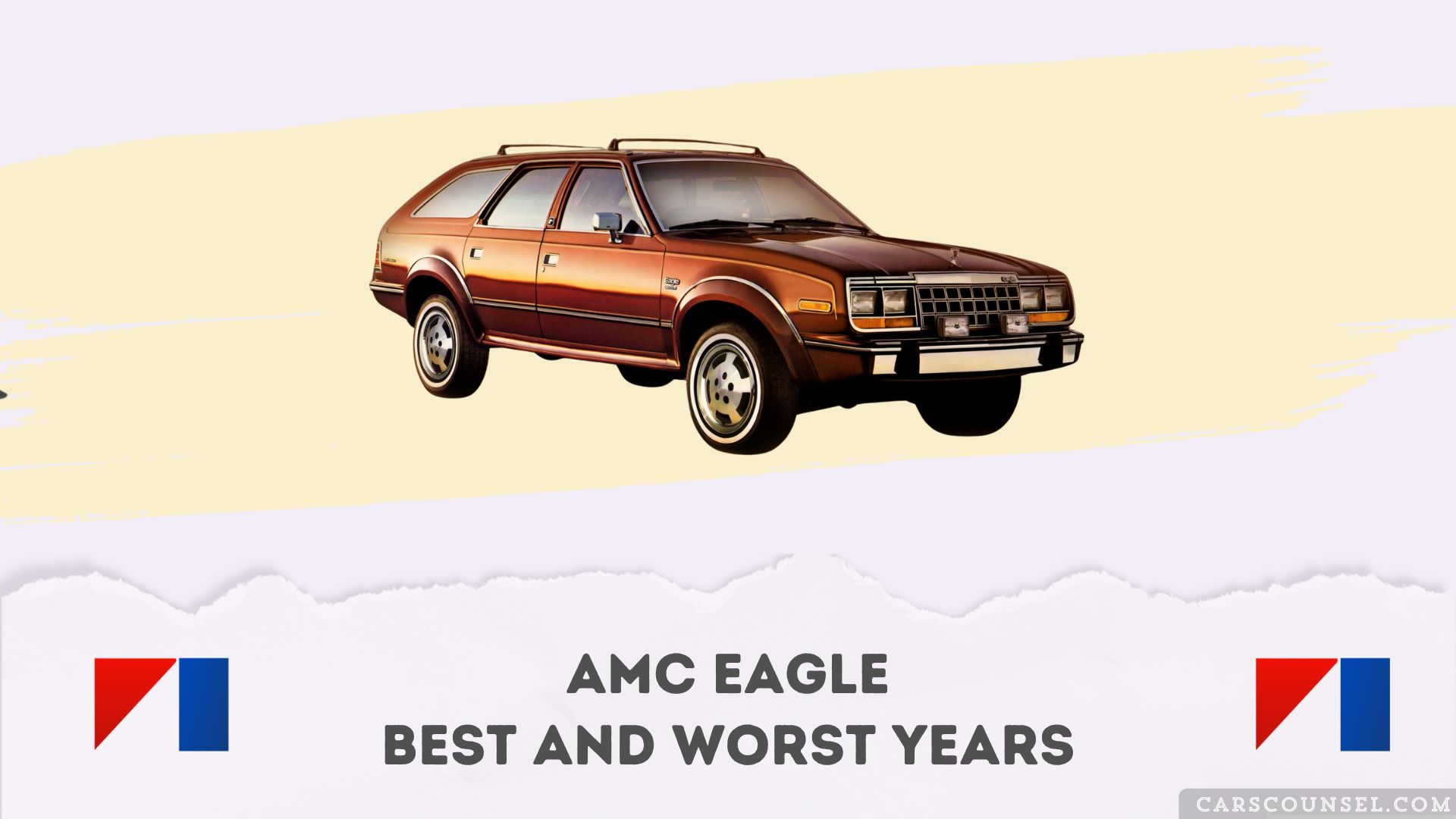As you step into the world of American Motors Corporation, a question echoes: Can an innovative risk-taker rise to fame and then fall into obscurity? The AMC Eagle’s story is a fascinating case study.
With annual sales exceeding 40,000 units from 1980 to 1982, considered its best years, it’s clear this car was once the darling of the market. But what triggered its downfall during its worst years, and how did it go from hero to zero?

Quick Navigation
Key Takeaways
- The best years for the AMC Eagle in terms of global sales were from 1980 to 1982, with over 40,000 units sold annually.
- The Eagle’s popularity waned by 1984, with the station wagon-only 1988 marking the Eagle’s demise.
- The 1981 and 1982 models offered a rare convertible option, the Sundancer, with only 700 units produced.
- The Eagle competed in the ProRally Series from 1981 to 1985, earning a reputation for durability and reliability.
- Approximately 145,000 Eagles were sold in the United States, roughly 75% of the model’s global sales.
Innovative Risk-Taking
As you venture the AMC Eagle’s pioneering spirit, you’ll discover that innovative risk-taking was the driving force behind this groundbreaking vehicle.
By combining the comfort of a passenger car with the ruggedness of a four-wheel drive utility vehicle, AMC created a unique crossover segment.
Its innovative all-wheel drive system, featuring a full-time automatic system, made it the first mass-produced U.S. 4WD automobile with an independent front suspension.
This bold move paved the way for the modern SUV market, solidifying the AMC Eagle’s position as a pioneer in the automotive industry, cementing its status as a groundbreaking innovator.
Identifying Niche Markets
As you delve into the AMC Eagle‘s success, you’ll notice that AMC targeted specific demographics, such as off-road enthusiasts and mountain dwellers, who needed a vehicle that could handle various driving conditions.
Target Demographics
When shopping for a vehicle, you likely consider factors like reliability, versatility, and practicality.
As an active outdoor enthusiast, you need a car that can keep up with your hiking, fishing, or skiing excursions.
You, urban dwellers, want a rugged yet practical vehicle for traversing city streets and rural landscapes.
Young professionals and small families you require a compact, fuel-efficient car for daily commutes.
If you live in regions with harsh weather conditions, the AMC Eagle’s all-wheel drive and raised ground clearance make it an attractive option for traversing.
Off-Road Enthusiasts
You’ve found a vehicle that’s tailor-made for your adventurous lifestyle: the AMC Eagle.
As an off-road enthusiast, you’ll appreciate the Eagle’s superior traction and stability in harsh weather conditions, thanks to its Quadra-Trac four-wheel drive technology.
The vehicle’s high ground clearance and advanced all-wheel drive system allow it to navigate rough terrain with ease.
Plus, the independent front suspension provides better traction on uneven terrain.
Whether you’re tackling light off-road adventures or just need a reliable ride, the AMC Eagle is designed to meet your off-road demands.
Mountain Dwellers
The AMC Eagle’s unique combination of passenger-car comfort and four-wheel drive security made it an attractive option for mountain dwellers who needed a reliable means of transportation under harsh weather conditions.
You benefited from the Eagle’s all-wheel drive capability, which offered a comfortable ride and handling on the road, as well as superior traction in moderate off-road excursions.
The Quadra-Trac system provided better traction and control in low-grip conditions, making it ideal for areas with heavy snowfall.
Its ruggedness and all-weather capability resonated with you, making it a reliable choice for getting around in mountainous regions.
Capitalizing on Four-Wheel Drive Technology
By integrating four-wheel drive technology, AMC created a game-changer in the automotive industry.
You benefited from the AMC Eagle’s full-time automatic AWD system, which operated quietly and smoothly.
The central unit’s wavy clutch plates in silicone fluid guaranteed torque was sent to the axle with the most grip.
This permanent all-wheel drive system was years ahead of competitors like Subaru.
You enjoyed a comfortable ride and superior traction in moderate off-road use, making the Eagle an affordable and capable choice.
The Eagle’s innovative four-wheel drive technology set a new standard in the industry.
Struggles With Competition
Several factors contributed to the AMC Eagle’s difficulties in competing with other four-wheel drive vehicles on the market.
You faced stiff competition from the Subaru Outback, which boasted better fuel economy and a lower sticker price.
The Eagle’s limited off-road capabilities, due to its lack of low-range gearing and limited ground clearance, made it less desirable.
Additionally, its high starting price of $6,999 in 1980, and limited dealership network further hindered its ability to attract buyers, making it a tough sell compared to more affordable alternatives.
Inability to Gain Widespread Acceptance
You might expect a car that pioneered the crossover segment to have gained widespread acceptance from the get-go. However, the AMC Eagle struggled to find its market niche. Its uniqueness, which created many talking points, also made it unattractive to some potential buyers.
| Reason | Description |
|---|---|
| Uniqueness | Made it unattractive to some potential buyers |
| Poor Reputation | Seen as a weird hybrid, not widely accepted in its time |
| Rarity | Only 20,000 units of the Eagle SX4 were produced |
The Eagle’s inability to gain acceptance kept it from going mainstream, making it a rare find for enthusiasts today.
Commercial Success and Demise
Despite its struggles to gain widespread acceptance, the AMC Eagle enjoyed a successful commercial run, at least initially.
You saw brisk sales, with the Eagle offering a low-price bridge between AMC’s passenger-car line and its well-regarded Jeep line.
However, by 1984 and station wagon-only 1988, the Eagle’s popularity waned.
Financial difficulties led to AMC’s sale to Chrysler Corporation in 1988 Eagle Wagon marked the Eagle’s demise.
The AMC Eagle’s commercial success was short-lived, but its innovative all-wheel drive system left a lasting impact on the automotive industry.
The Concept and Model Years
You’re looking at the AMC Eagle, a vehicle that redefined the auto industry with its innovative concept.
As you delve into the concept and model years, you’ll see that AMC’s production plans involved introducing various body styles, including coupe, sedan, and station wagon.
From 1980 to 1988, the Eagle underwent significant changes, with model year variations that shaped its eventual impact on the market.
Early Design Principles
The AMC Eagle’s early design principles revolved around creating a crossover vehicle that combined passenger-car comfort with four-wheel drive security. You wanted a car that provided an affordable price tag, a comfortable interior, and superior traction in moderate off-road use. Roy Lunn, chief design engineer for AMC Jeep, proposed a vehicle with the comfort of an automobile and the ride height and adverse-weather capabilities of a four-wheel drive utility vehicle.
| Feature | Description |
|---|---|
| Ride Height | Similar to a four-wheel drive utility vehicle |
| Four-Wheel Drive | Permanent all-wheel drive (AWD) system |
| Body Style | Unibody platform, similar to a passenger car |
| Handling | Conventional rear-wheel drive car handling |
AMC’s Production Plans
AMC’s production plans for the Eagle aimed to capitalize on the vehicle’s unique blend of passenger-car comfort and four-wheel drive security.
Initially, you’ll see that AMC planned to produce 1980 Eagle models at a rate of 40,000 units per year, which was later doubled to 80,000 units due to high demand.
As you examine the AMC cars, you’ll notice the Eagle was first offered as a 1980 model, with a price starting at $6,999 for the basic two-door model and $7,549 for the 4-door station wagon.
The Eagle line would continue to evolve over the model years.
Model Year Variations
From concept to reality, the Eagle underwent significant transformations across its model years, reflecting AMC’s commitment to innovation and customer feedback.
As you delve into the Eagle’s model year variations, you’ll notice significant changes to the Eagle lineup. For instance, the 1980 model year saw the introduction of the Eagle, a cross-over that blended car-like comfort with SUV capabilities.
The base model was upgraded in 1981, featuring improved interior amenities and exterior styling.
Throughout its production run, the Eagle underwent refinements, ensuring it remained competitive in the market.
Sundancer Convertibles and Turbo Diesel
As you explore into the AMC Eagle’s unique features, you’ll discover that 1981 and 1982 models offered a rare convertible option – the Sundancer.
This conversion, performed by the American Sunroof Company, added around $1,000 to the base price, making it an affordable convertible option in the early 1980s.
Only 200 were produced in 1981 and 500 in 1982, making them extremely rare and sought after by collectors today.
Unfortunately, the planned turbo diesel engine never materialized due to AMC’s struggles, limiting the Eagle’s appeal in terms of fuel efficiency and towing capacity.
Racing Legacy in the ProRally Series
You step into the world of professional rally racing, and its rich history is marked by the AMC Eagle’s impressive performance.
From 1981 to 1985, the Eagle competed in the ProRally Series, earning a reputation for durability and reliability in demanding conditions.
In 1982 Overall Championship, Rod Millen drove the Eagle to victory, beating out lighter and more powerful competitors.
The following year, John Buffum secured a top-three finish, solidifying the Eagle’s status as a formidable contender.
The Quadra-Trac all-wheel-drive system provided superior traction and control, making the Eagle a force to be reckoned with in the ProRally Series.
International Markets and Legacy
As you venture into the AMC Eagle’s international markets, you’ll discover that this rugged vehicle made a significant impact globally.
From its strong sales performance in the 1980s to its niche appeal in countries like Australia, its global presence contributed to its enduring legacy.
You’ll find that the Eagle’s international sales and marketing efforts played a vital role in establishing a global footprint.
Global Sales Performance
During its production run, approximately 145,000 Eagles were sold in the United States, which is roughly 75% of the model’s global sales.
You might be surprised to learn that the Eagle’s best years in terms of global sales were from 1980 to 1982, with over 40,000 units sold annually.
The Eagle dominated its market segment, capturing a significant share of Sales of AMCs in the United States.
Its success can be attributed to its unique features, which set it apart from other cars in its class.
European Market Share
The AMC Eagle’s absence from European markets is a notable aspect of its international presence.
You might wonder why American Motors Corporation didn’t tap into the European market. The answer lies in the significant investments required for homologation, marketing, and distribution, which made it unviable.
The Eagle’s unique features would have drawn a niche audience, but the market was already saturated with established brands. Additionally, the Eagle’s larger size and lower fuel economy were significant disadvantages in the 1980s European market, dominated by smaller, fuel-efficient vehicles.
Legacy Impact
You might expect the AMC Eagle‘s international absence to have limited its legacy impact, but surprisingly, it has contributed to a distinct identity.
As a pioneering cross-over vehicle, the Eagle’s influence can be seen in modern vehicles that have followed in its footsteps.
The automotive industry has taken note of its innovative design, and many manufacturers have developed their own cross-over vehicles.
Today, its legacy lives on, and the AMC Eagle is remembered as a groundbreaker in the world of cross-over vehicles.

